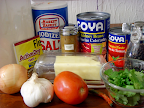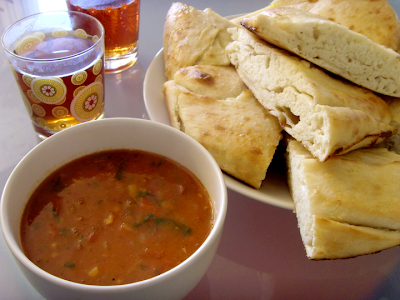Background
Yemen is located on the southern coast of the Arabian Pennisula, making it a key port in the spice trade. Most sources credit the Ottoman Empire as the only outside influence on the cuisine, but they do not give any specifics. The major protein sources are chicken, lamb, and beans. Dairy is not common in the diet except for ghee.
We didn't have much trouble finding out what dishes are served at breakfast, but finding recipes proved difficult as spellings are not standardized. The only book I found on Yemeni cuisine focused specifically on a small Jewish community in the country. Looking online, there are several recipes available for fasoolia, a bean and tomato dish. It is traditionally eaten with a massive piece of flat bread called malooga. The bread is made by folding semn into the dough. Semn is a darkened ghee and is easily made at home.
It is served with sweet tea flavored with cardamom.
 Fasoolia
FasooliaWe went online for our recipes this week. The same fasoolia recipe is found all over the internet and can be found here.
Using the masher did not break up the beans very well and I would use a stick blender in future attempts.
Malooga
The malooga and semn instruction can be found here.
1 stick of butter gives you a little more than 1/3 cup of useful semn while keeping the burned pieces on the bottom.
The recipe made one piece according to the measurements suggested; we did not divide it into smaller parts as directed. When baking the malooga, be sure to use an edged cookie sheet: the semn is very lubricating, and the higher oven temperature may cause your baking sheet to warp and your malooga to slide off!
Results and Discussion
The fasoolia was a really nice dish and comes together very quickly. The combination of cumin, tomato, and cilantro is classic. It is also very warm and filling.
The real treat for this breakfast was the malooga. Most of our previous flat breads are pretty simple and created as almost an after though. The malooga was much more involved than previous flat breads. Not rolling the dough after each fold, and then making a ball leads to the creation of irregular layers. They flake off very nicely for dipping and scooping. The bread keeps well over night. I would like to use this recipe for pizza dough. (I am sure Yemenis do this already and call it something else! –Kitty)

No comments:
Post a Comment